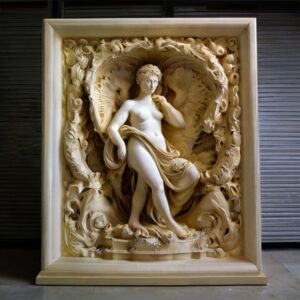Art has unceasingly evolved through the ages, continuously incorporating new materials and techniques that challenge traditional notions and open the doors to groundbreaking expressions and durability. Among such innovative materials, polyurea has transitioned from its origins in industrial applications to becoming a robust medium in the realms of art and sculpture. This transformation enhances artistic creativity and substantially contributes to the longevity and preservation of artworks exposed to various environmental elements.
Polyurea’s Role in Modern Art

Polyurea’s emergence as a favored material among modern artists and sculptors is largely due to its superior strength and ability to cure at an exceptionally fast rate. Its complex chemical makeup ensures a robust and flexible coat and delivers impressive resilience against wear and tear, adverse weather, chemical degradation, and physical disturbances. This makes polyurea perfectly suited for outdoor artworks, such as sculptures and large-scale installations, which must endure varying climatic conditions over extended periods. The rapid cure time of polyurea is particularly beneficial in the artistic world. It sets quickly, reducing waiting periods significantly, which traditionally hindered the creative flow. This efficiency allows artists to engage in more ambitious projects with less concern about delays due to material setting times. They can manipulate and transform the polymer to realize intricate designs and elaborate concepts that were once not feasible with slower-drying, less resilient materials.
Furthermore, the adaptability of polyurea extends beyond simple application. It can be combined with a variety of colorants and textural elements, providing artists with an expansive palette and range of textures to explore and incorporate into their work. This fusion of artistic potential and practical benefits helps dissolve the boundaries imposed by traditional materials, granting contemporary artists the freedom to push the limits of their creative vision. By employing polyurea, artists achieve a durable final product and embrace a form of expression that is continually evolving, mirroring the dynamic, exploratory spirit of modern art.
Techniques for Integrating Polyurea in Artistic Works
How do artists incorporate this unique material into their creations? Here’s a glimpse into some common techniques:
- Molding: artists often begin by creating a mold of their desired shape from clay or another material.
- Application: polyurea is then sprayed or poured into the mold, adhering to its contours perfectly.
- Finishing: after curing, the sculpture is removed from the mold and finishing touches are applied, which can include painting, carving or sanding.
This technique helps in crafting sculptures that stand the test of time, resist environmental wear, and require minimal maintenance.
Enhancing Aesthetic Appeal with Polyurea
Polyurea offers a vast array of creative possibilities in terms of aesthetic customization, which can significantly enhance the visual appeal of an artwork. The polymer can be precisely manipulated during the application process to achieve various textures such as smooth, rough, or ribbed surfaces. This ability to tailor the tactile quality of the material adds an extra layer of depth and interest to sculptures, inviting visual and physical interaction. For artists, this means greater freedom to express their vision through the shape and structure of the artwork and its surface feel, enabling a more immersive and engaging experience for the audience.
Polyurea’s compatibility with colors widens the scope of artistic expression. Artists can blend different pigments directly into the polyurea before it is applied, allowing the color to become an integral part of the sculpture rather than a superficial layer. This results in vibrant, enduring colors that are resistant to fading and wear. Alternatively, once cured, polyurea surfaces can readily accept various paints, allowing artists to refine or transform the artwork with intricate patterns and detailed finishes post-application. This dual approach to coloring opens up limitless possibilities in design and finish, making polyurea an immensely versatile and attractive choice for both abstract and thematic sculptures. Whether aiming to evoke specific emotions, complement an environment, or convey particular themes, polyurea-equipped artists can precisely tailor their color schemes to enhance the communicative power of their artworks.
Polyurea in Iconic Artworks
The growing adoption of polyurea in the art world is underscored by its use in various prominent projects, illustrating its compatibility with the diverse needs and inventive ambitions of artists globally. In New York, a renowned sculptor has turned to polyurea to protect and preserve a series of ambitious outdoor installations. These artworks, positioned in environments prone to extreme weather fluctuations, benefit enormously from polyurea’s weather-resistant properties, maintaining their aesthetic integrity and vibrancy despite exposure to intense sun, rain, and snow. This longevity ensures that the sculptural works continue to engage the public and enrich the urban landscape over time, a testament to the material’s robust nature.
In Europe, another artist has embraced polyurea for its practical advantages in creating sculptures for a traveling exhibition. The inherent toughness and lightness of polyurea facilitate the safe and efficient transport of these artworks across multiple locations. The sculptures endure the continual processes of packing, unpacking, and handling, which are typical in exhibitions that move from venue to venue. This resilience safeguards the artistic value and structural stability of the pieces and reduces the need for frequent repairs or restoration, making polyurea an optimal choice for displays that must remain pristine over long periods and through numerous transport cycles.
These examples highlight polyurea’s pivotal role in modern art installations and exhibits, where both durability and visual impact are critical. By providing a reliable medium that thrives under challenging conditions and fulfills the creative needs of artists, polyurea is solidifying its place as an essential material in the repertoire of contemporary art practices.
